An In-depth Interview with a Real Life Ninja in the Ninja City of Iga in Mie Prefecture
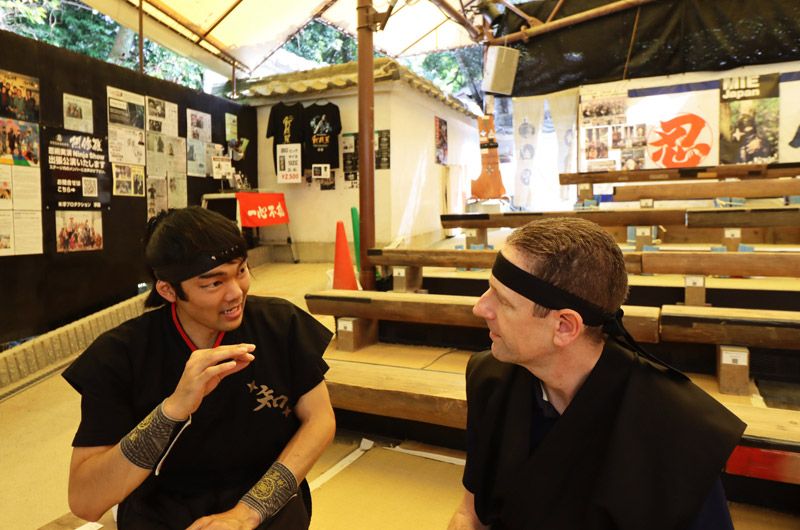
The Iga Ninja, also known as Iga-ryu Ninja, were a legendary group of shadow warriors from the Iga-Nabari region of Mie Prefecture. They were renowned for their exceptional skills in stealth, espionage, and covert warfare during Japan’s feudal age (1185-1603). This quiet part of western Mie Prefecture was the perfect place for their deadly art form to develop in secrecy.
Written by John Asano
Table of Contents
・The Key Aspects of Iga-ryu Ninja
・The Ashura Ninja Group
・Interviewing a Real Life Ninja
・Wrap Up
・How to Get There
The Key Aspects of Iga-ryu Ninja
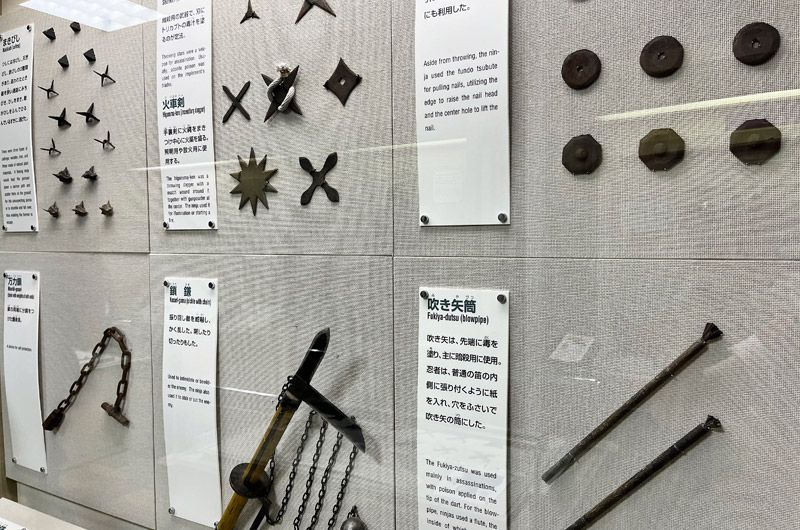
One of the primary roles of the Iga-ryu ninja was intelligence gathering. They were highly skilled in gathering information through covert means, including infiltration of enemy territory, eavesdropping and surveillance. Very much like a modern-day spy.
The Iga-ryu Ninja operated in a time of political unrest and civil war in Japan with various daimyo (feudal lords) jostling for power and control of the nation. They were often employed by daimyo to carry out covert operations against rival factions or simply gather intelligence during times of conflict.
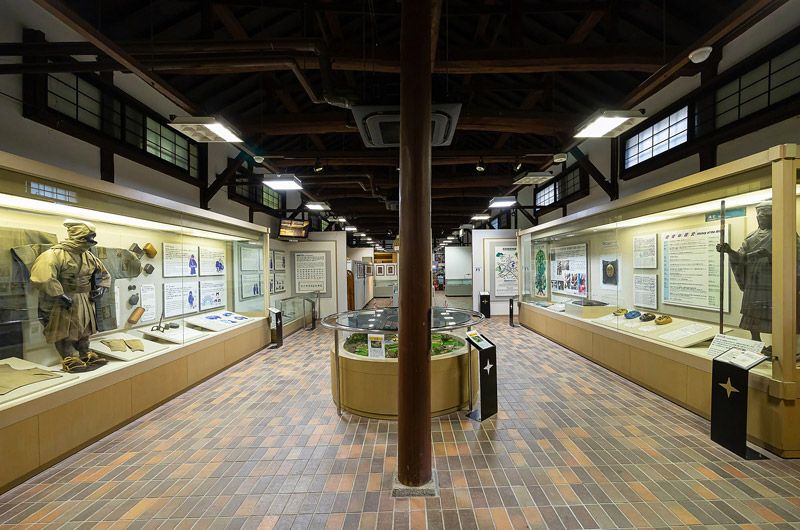
The Ashura Ninja Group
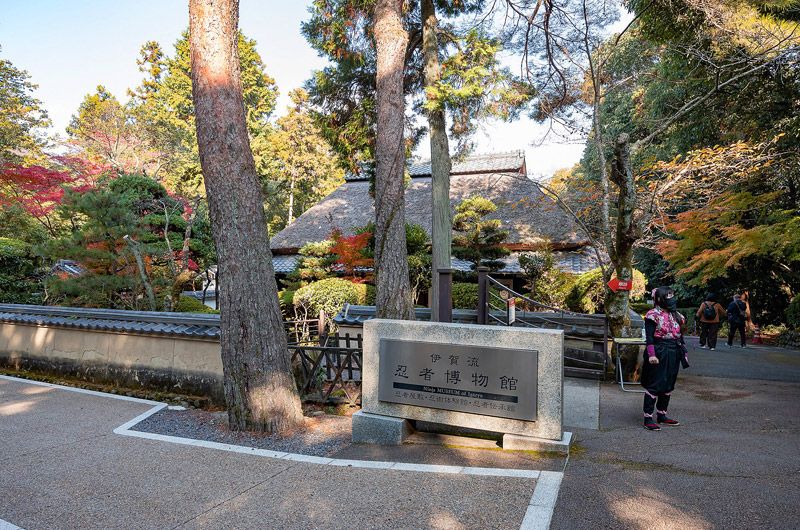
Interviewing a Real Life Ninja
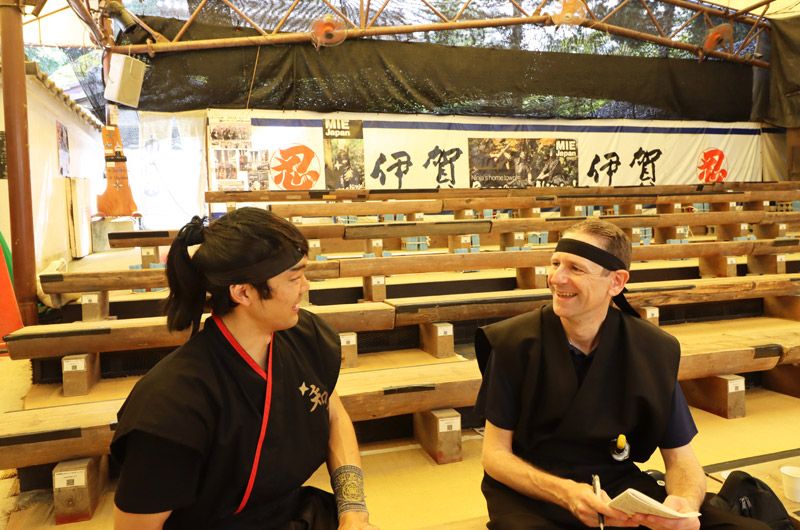
Here is the full interview with Tomonosuke.
John: What is the Iga-style of ninjutsu?
Tomonosuke: Iga can be said to be the origin of ninjutsu. This is where Japanese ninja and ninjutsu were born over 500 years ago. Various schools of ninjutsu were created throughout Japan based on the Iga style of ninjutsu.
John: I see. Does that mean that this is the place where ninjutsu was born?
Tomonosuke: That’s right!
John: Very cool. It really is the birthplace of ninja.
Tomonosuke: Do you want to know the roots of its birth?
John: Yes, please tell me.
Tomonosuke: To tell you something profound, Iga-Nabari is now an area that has been cut open. In the past, it was overgrown with grass and trees and surrounded by mountains. It was foggy and dense, and no one would go near it. This made it the perfect place for political exiles and fallen warriors to hide in seclusion. The power of the feudal lords was weak here, so when something happened, they were not protected. They had to learn to survive on their own and become stronger. To do this, they trained in the mountains and developed their own fighting techniques. Over time, those with less strength gradually became stronger and later came to be called ninja. These are the roots of the Iga-ryu Ninja.
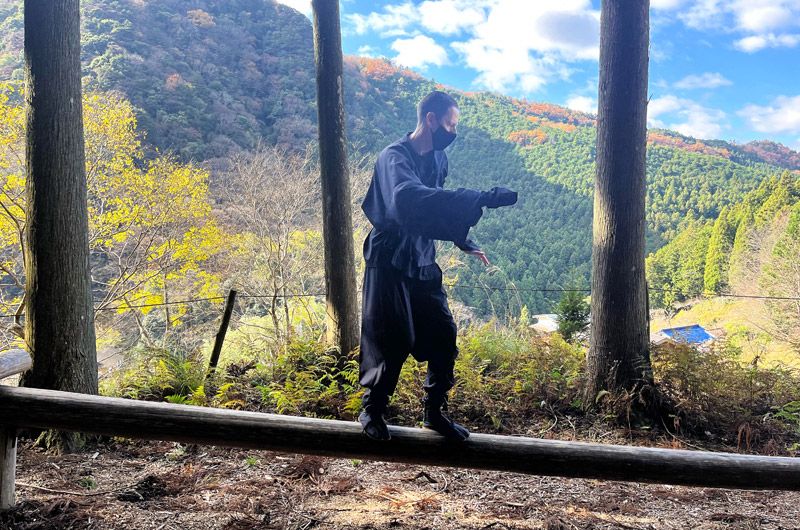
John: How long ago was this?
Tomonosuke: Ninja have existed for about 500 years. It is said that they may have been around since the time of Prince Shotoku (574-622), even before the Warring States Period (1467-1567).
John: Today’s ninja show was entertaining and funny. I loved how it had humor in it even in English. I was laughing along with all the jokes and even the little old Japanese lady sitting next to me was also laughing at the humor in English.
Tomonosuke: When I use English, I try to use simple English that Japanese people can understand. I want people from both overseas and Japan to enjoy themselves in the same atmosphere so that there is no distance between them. We try to make sure that everyone can enjoy the show together.
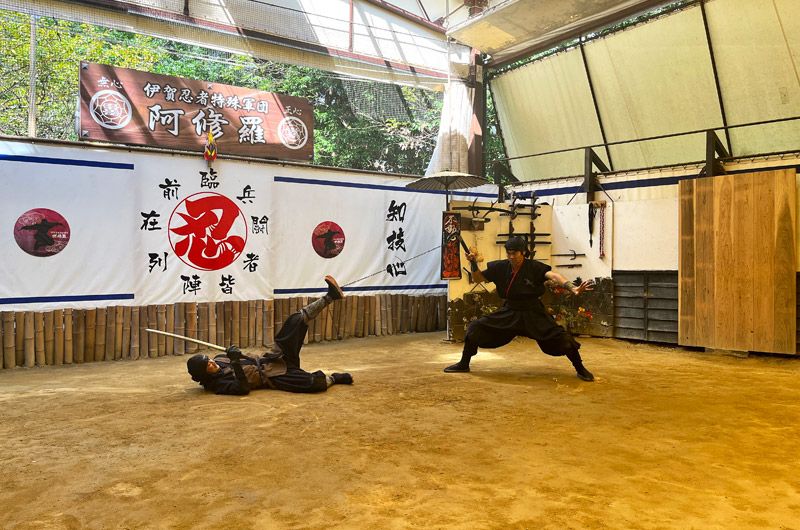
Live ninja action at the ninja show
John: What is the Ashura Group?
Tomonosuke: It is a group founded by my father. He has been a ninja since I was born, and I have been trained in ninjutsu by him since I was five years old. I am a professional spy because I have never worked or had a part-time job, except as a ninja. I am 37 years old now, so it’s been about 32 years. Each member of Ashura has exceptional talent. They have discovered and developed these talents on their own. We are a group of specialists with each member having their own area of expertise, and we make the most of it.
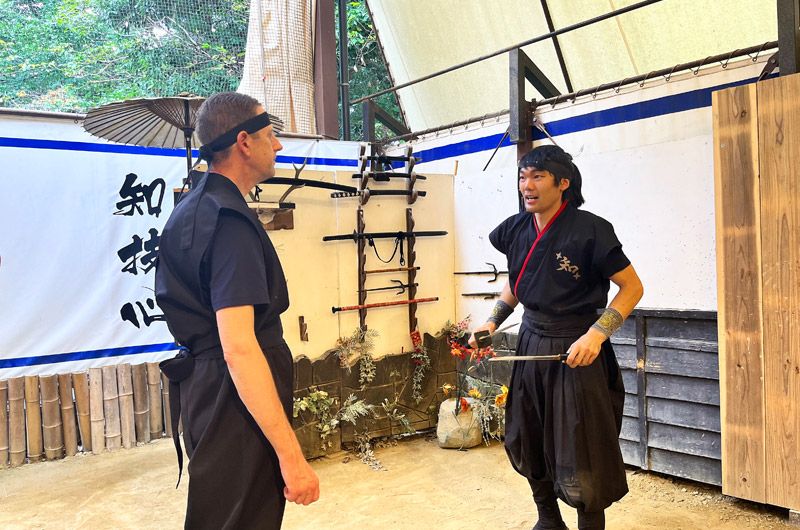
John: Does everyone practice ninjutsu every day?
Tomonosuke: Yes, it is a routine or habit just like brushing my teeth. I train and workout to build my body and train my mind to avoid injury and illness. Small injuries and illnesses happen when you let your guard down. I still haven’t gotten the hang of it yet, but my father has. He hasn’t taught me those tricks as he wants me to discover them myself. My father says that when this does not happen anymore, I’ll be a first-class ninja, so I guess that I am not a first-class ninja yet.
John: How do the Iga and Koga style of ninjutsu differ?
Note: Koga-ryu is a style of ninjutsu that developed in the Koga area of nearby Shiga Prefecture.
Tomonosuke: Dare I say that there are no major differences, only minor differences. Iga-ryu Ninja are skilled in gunpowder techniques and are good at using fire. On the other hand, Koga-ryu Ninja are skilled in medicine and are good at techniques and skills using medicine. This is the main difference. During the Warring States Period (1467-1567), ninja were active as gunners. In the Edo Period (1603-1868), they were involved in espionage like you see in 007 or Mission Impossible, where they infiltrate enemy territory and bring back information. After the Meiji Era (1868-1912), the paths of the Iga and Koga Ninja diverged greatly. Many Iga-ryu Ninja became pyrotechnicians making use of their knowledge of gunpowder, while Koga-ryu Ninja used their knowledge of medicine to become pharmacists. Even today, there are many pharmaceutical companies in the Koga region of Shiga Prefecture.
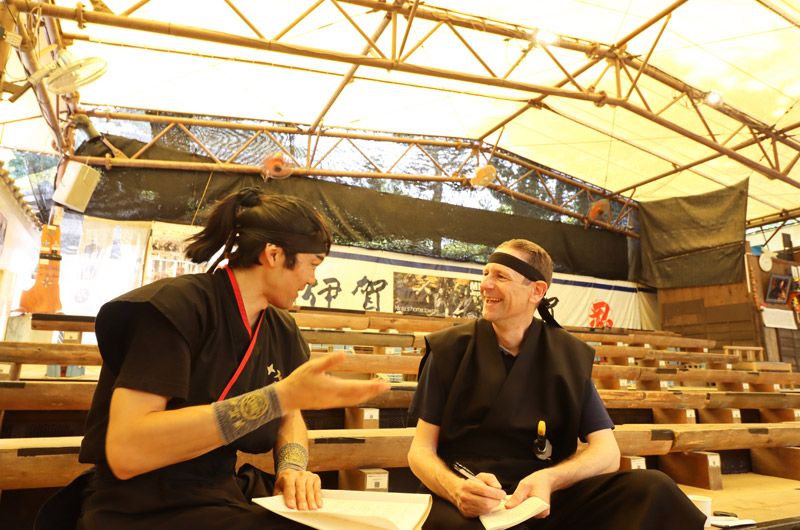
John: What kind of training do you do?
Tomonosuke: Every day, we are building our bodies and training our minds to avoid injury and illness.
John: Do you also train in the gym or do any sports to keep fit?
Tomonosuke: Yes, we do. In the ninja world, it is said that all you need is muscle strength to support your own weight.
John: Do you eat any special food?
Tomonosuke: In the past, ninja did not eat meat before going on a mission to avoid smelling and being noticed by the target. There are no special regulations, but I eat bananas and yogurt every morning.
John: Tell us about the daily life of a ninja.
Tomonosuke: In the past, ninja were mostly farmers who could disguise themselves and become someone else when on a mission. They would sneak into enemy territory and gather important information or spread false rumors to confuse the enemy. Today, we are just like you. We live a regular life.
John: Tell us about your recent activities.
Tomonosuke: My work was greatly reduced during the Coronavirus pandemic, so I started fortune telling every day. Did you know that there is a special fortune telling technique using ninjutsu?
John: I didn’t know that. Tell us more.
Tomonosuke: In fact, ninjas can tell fortunes. It made the world news. I was making predictions about the winner of each match at the soccer world cup and rugby world cup as well as other sports such as baseball and basketball by spinning a traditional Japanese umbrella. We had a big drop in customers during the pandemic, so there was nothing to do. I found a new path. Ninja joke! I was still working out and doing traditional ninja training every day. We are also currently working with the Japanese government and Mie Prefecture to promote ninja to the rest of the world. The governor of Mie took us to Sao Paulo in Brazil to perform and we were well received by the people there.
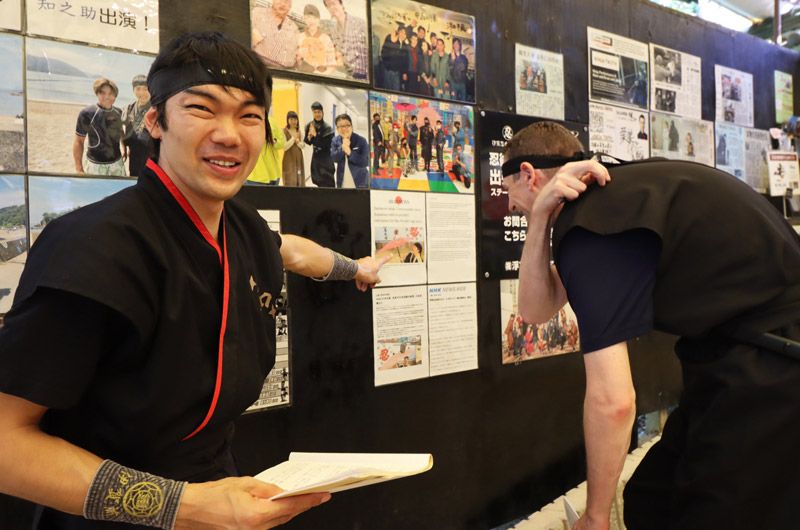
John: People in Brazil are extremely interested in martial arts. They have their own form of martial arts such as Capoeira.
Tomonosuke: Many people in Brazil are interested in Japanese food, martial arts, and culture. When I first went to perform there, I said I was a ninja and they offered me broccoli. Apparently, broccoli in Brazil is called ninja. A Japanese person brought it to Brazil and asked what they should call it. They researched Japanese culture such as samurai, maiko and ninja, and decided that it should be ninja. What is Japan? Ninja. This shows how popular ninja are in Brazil.
John: You said that you became a ninja at the age of five. Why did you become a ninja?
Tomonosuke: My father cheated me! When I was young, I dreamt of being a movie actor or a voice actor. When I talked to my father about it, he said that being a ninja was the quickest way to become a movie actor or voice actor. I still haven’t fulfilled that dream! I have been a ninja for 32 years because my father deceived me (laughing). Will my dream come true one day?
John: What is the spiritual aspect of ninja?
Tomonosuke: The ninja follow the principles of benevolence, justice, loyalty, and fidelity. The ninja had a compassionate heart and would do what is right, without lying, and serve their lord with sincerity. The first thing my father taught me was benevolence and loyalty. Be considerate to others and do not lie. Do what is right and follow the path you believe in. That is the way to be a ninja.
John: Ninja Truth! There is a difference between real ninjas and ninjas portrayed in films. It was really nice to see a real ninja in the performance today. You dispelled some myths about ninjas in your show, which I found fascinating.
Tomonosuke: As I said before, we can’t tell lies. We can only tell the truth.
John: Yes, people from other countries have a strong image of ninjas from movies and manga such as Naruto. They are interesting, but it is important for people to know the truth.
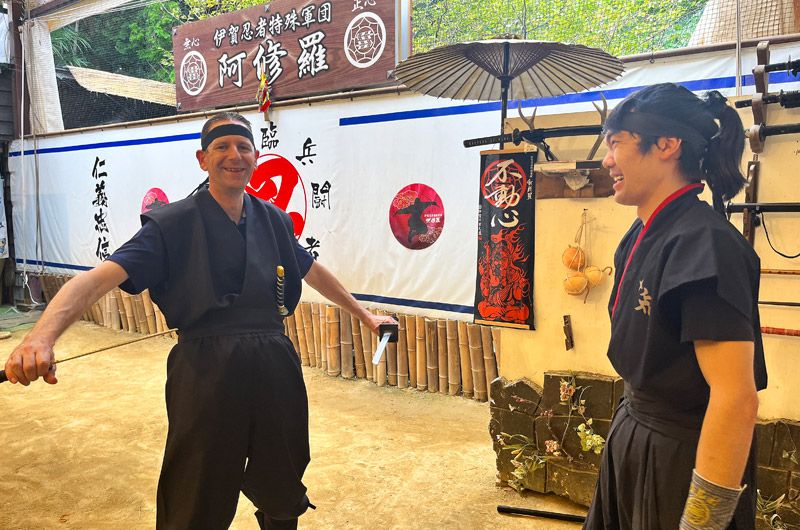
John: Are there any tourist attractions in Mie Prefecture that you would recommend?
Tomonosuke: The most memorable place that I have visited is Koubenomiya Yomou Jinja in Taiki Town in the Watarai District of Mie. It is a shrine that is said to make you smarter. A lot of high school and junior high school students visit during the examination season. There is a stone here that reflects people’s faces. The number of faces that can be seen varies from person to person depending on the angle and the person looking at it. I became smarter after visiting this shrine (laughs). I was an idiot until then.
John: There are so many interesting shrines in Mie. Are foreign visitors welcome to Iga?
Tomonosuke: Yes, I would like to invite people from all over the world who are interested in ninjutsu. My dream is to teach them the Iga ninjutsu that my father taught me. One day, somewhere in the world or here in Japan, I will establish an Iga-ryu ninjutsu dojo.
John: Yes, people watch a performance here at your show and then want to try it themselves. It is a bit dangerous, so a dojo would be a great place to learn and practice ninjutsu.
Tomonosuke: It is a big dream and I need to meet the right people in order to set it up. Iga-ryu ninjutsu can teach valuable self-defense techniques that can be used in modern life or in emergencies. I would also like to give lectures on the various ways to use shuriken and various other weapons.
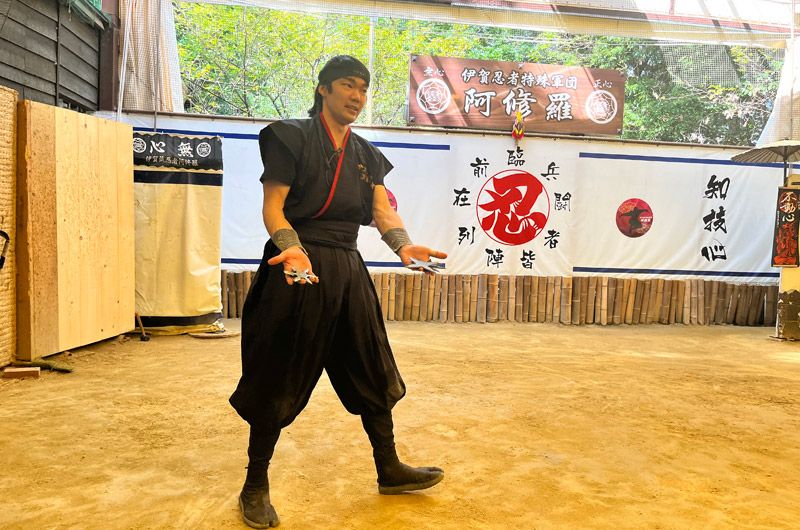
John: I saw some tools for walking on water at the Iga-ryu Ninja Museum. I would love to try it.
Tomonosuke: Most people sink, but if you do it right, you can walk on water. I don’t think anyone else in the world knows about it. Just me, my father, and his teacher. When the dojo is built, it could be a world premiere. The whole world will be surprised.
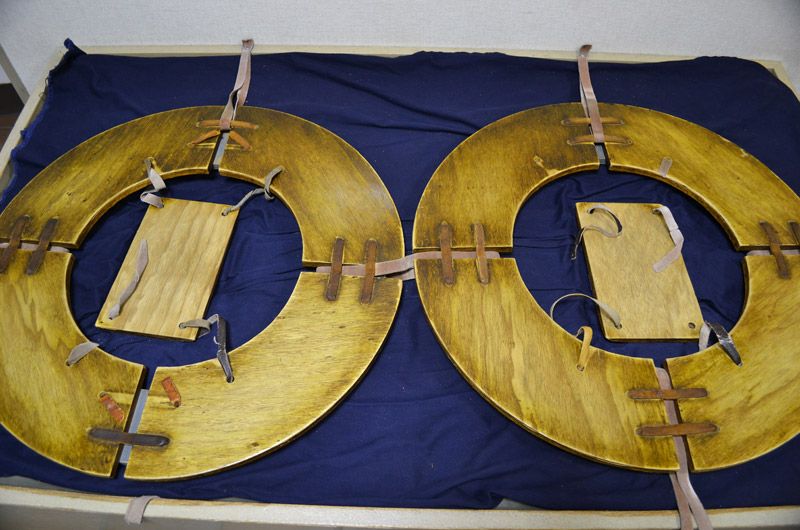
John: Finally, please give a message to foreigners interested in ninjutsu.
Tomonosuke: Please come to Iga and meet genuine ninjas. I would like you to visit us here at the Iga-ryu Ninja Museum and see real ninjas who live only as they once did in the past. There are still things that people today can learn from ninjas, so I want as many people as possible to be interested in ninja and the Iga-ryu Ninja.